Analyzing Organizational Communication Issues at Sasol Limited
VerifiedAdded on 2023/06/18
|11
|2792
|337
Report
AI Summary
This report delves into the critical aspects of organizational communication within Sasol Limited, a South African integrated energy and chemical corporation. It identifies communication barriers, particularly language differences arising from a diverse workforce, and their impact on productivity and employee satisfaction. The report emphasizes the importance of effective communication for team collaboration, innovation, and overall organizational success. Strategies to overcome these barriers, such as language training, the use of interpreters, visual communication methods, and communication audits, are discussed. The use of questionnaires is suggested to assess communication effectiveness and employee feedback. Ultimately, the report concludes that improving communication can enhance cooperation, morale, and productivity within Sasol Limited. Desklib provides access to this and many other solved assignments.
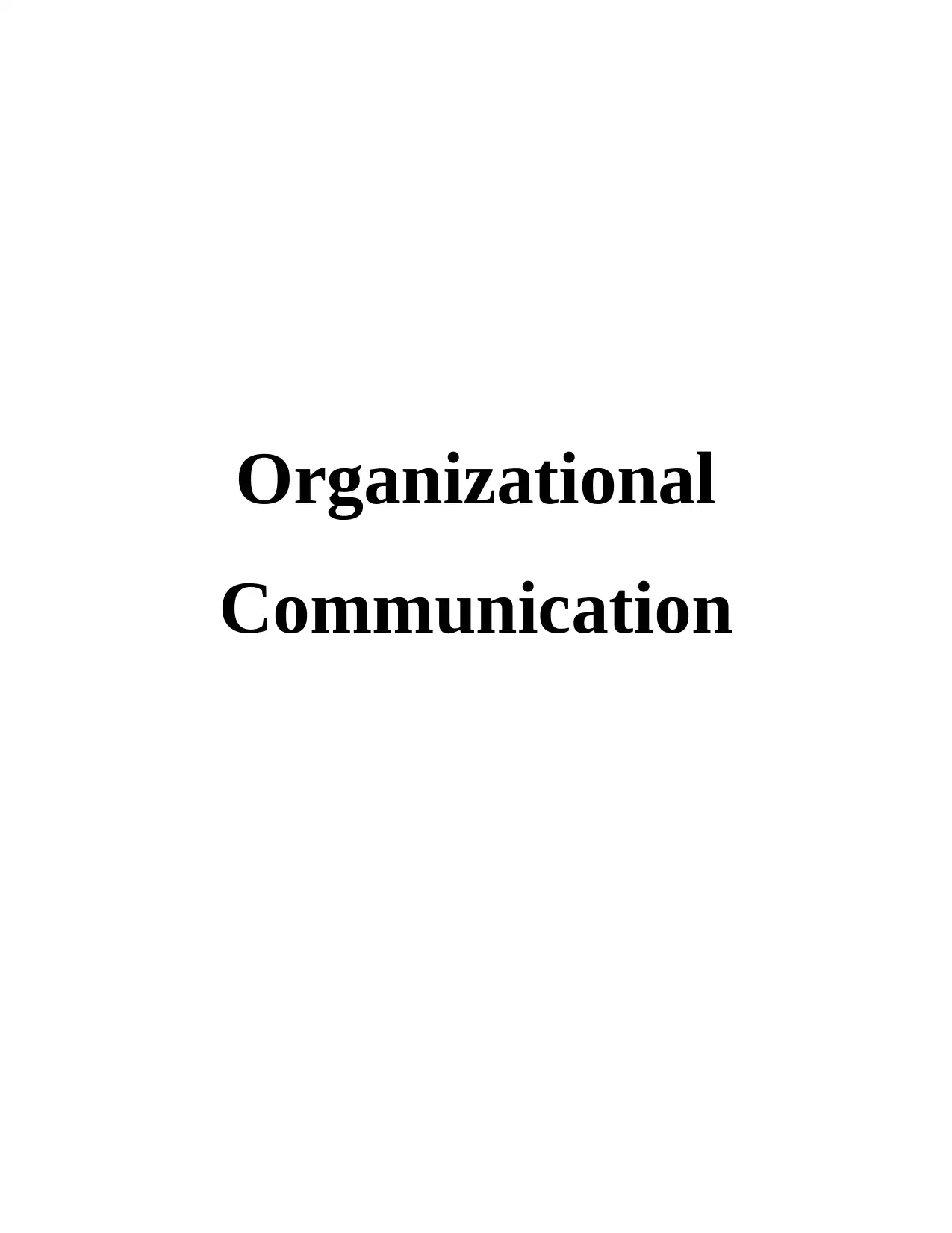
Organizational
Communication
Communication
Paraphrase This Document
Need a fresh take? Get an instant paraphrase of this document with our AI Paraphraser
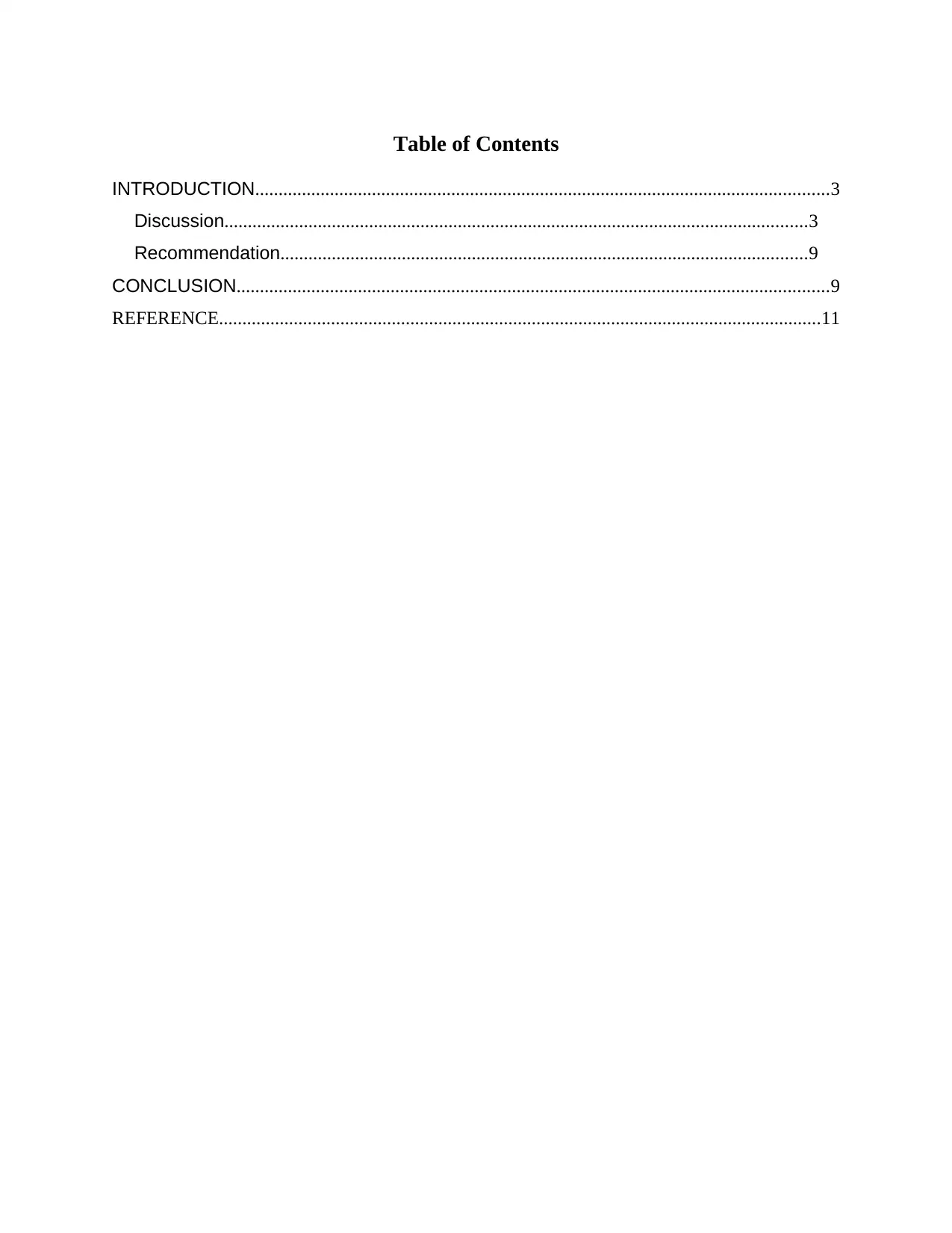
Table of Contents
INTRODUCTION...........................................................................................................................3
Discussion.............................................................................................................................3
Recommendation.................................................................................................................9
CONCLUSION...............................................................................................................................9
REFERENCE.................................................................................................................................11
INTRODUCTION...........................................................................................................................3
Discussion.............................................................................................................................3
Recommendation.................................................................................................................9
CONCLUSION...............................................................................................................................9
REFERENCE.................................................................................................................................11
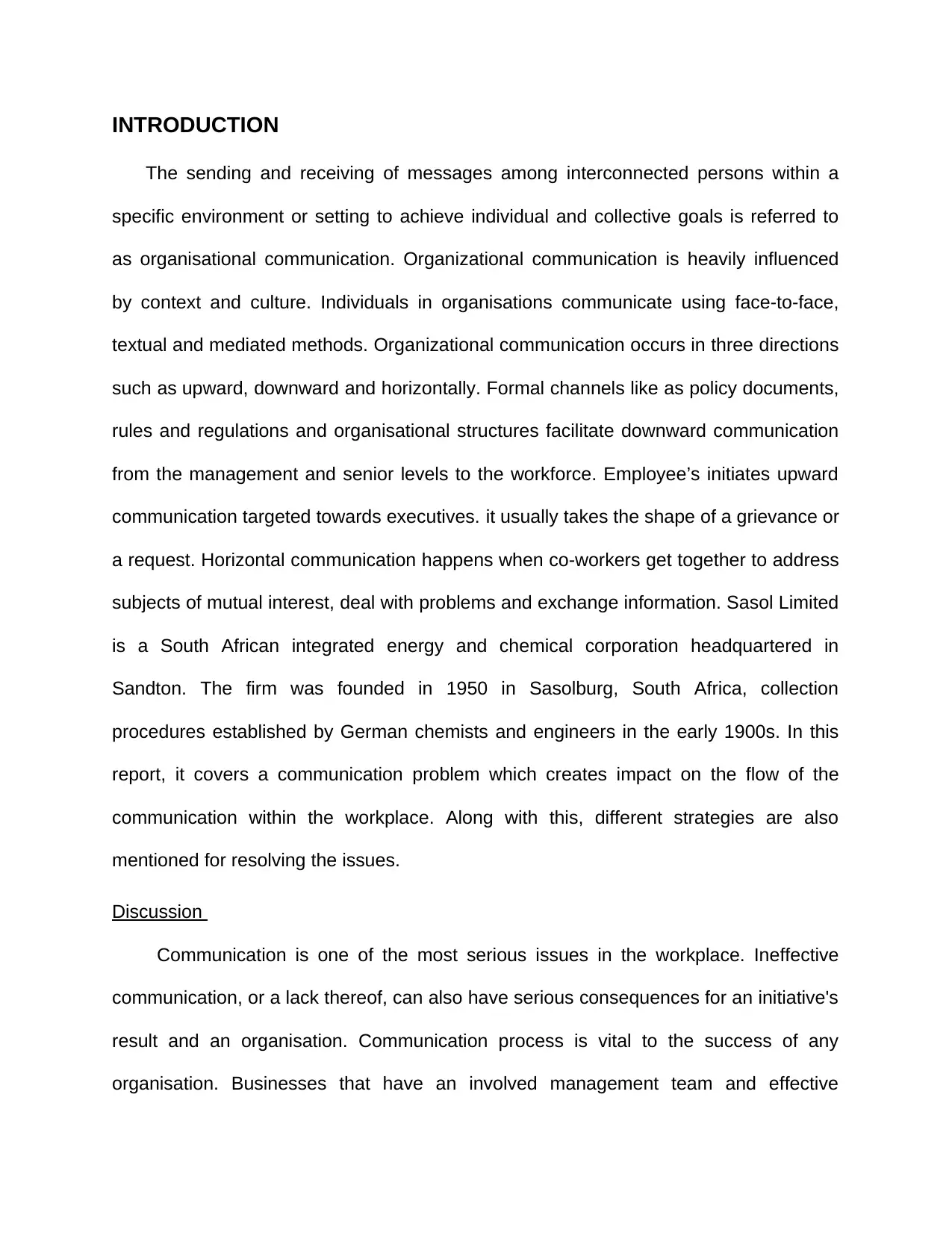
INTRODUCTION
The sending and receiving of messages among interconnected persons within a
specific environment or setting to achieve individual and collective goals is referred to
as organisational communication. Organizational communication is heavily influenced
by context and culture. Individuals in organisations communicate using face-to-face,
textual and mediated methods. Organizational communication occurs in three directions
such as upward, downward and horizontally. Formal channels like as policy documents,
rules and regulations and organisational structures facilitate downward communication
from the management and senior levels to the workforce. Employee’s initiates upward
communication targeted towards executives. it usually takes the shape of a grievance or
a request. Horizontal communication happens when co-workers get together to address
subjects of mutual interest, deal with problems and exchange information. Sasol Limited
is a South African integrated energy and chemical corporation headquartered in
Sandton. The firm was founded in 1950 in Sasolburg, South Africa, collection
procedures established by German chemists and engineers in the early 1900s. In this
report, it covers a communication problem which creates impact on the flow of the
communication within the workplace. Along with this, different strategies are also
mentioned for resolving the issues.
Discussion
Communication is one of the most serious issues in the workplace. Ineffective
communication, or a lack thereof, can also have serious consequences for an initiative's
result and an organisation. Communication process is vital to the success of any
organisation. Businesses that have an involved management team and effective
The sending and receiving of messages among interconnected persons within a
specific environment or setting to achieve individual and collective goals is referred to
as organisational communication. Organizational communication is heavily influenced
by context and culture. Individuals in organisations communicate using face-to-face,
textual and mediated methods. Organizational communication occurs in three directions
such as upward, downward and horizontally. Formal channels like as policy documents,
rules and regulations and organisational structures facilitate downward communication
from the management and senior levels to the workforce. Employee’s initiates upward
communication targeted towards executives. it usually takes the shape of a grievance or
a request. Horizontal communication happens when co-workers get together to address
subjects of mutual interest, deal with problems and exchange information. Sasol Limited
is a South African integrated energy and chemical corporation headquartered in
Sandton. The firm was founded in 1950 in Sasolburg, South Africa, collection
procedures established by German chemists and engineers in the early 1900s. In this
report, it covers a communication problem which creates impact on the flow of the
communication within the workplace. Along with this, different strategies are also
mentioned for resolving the issues.
Discussion
Communication is one of the most serious issues in the workplace. Ineffective
communication, or a lack thereof, can also have serious consequences for an initiative's
result and an organisation. Communication process is vital to the success of any
organisation. Businesses that have an involved management team and effective
⊘ This is a preview!⊘
Do you want full access?
Subscribe today to unlock all pages.

Trusted by 1+ million students worldwide
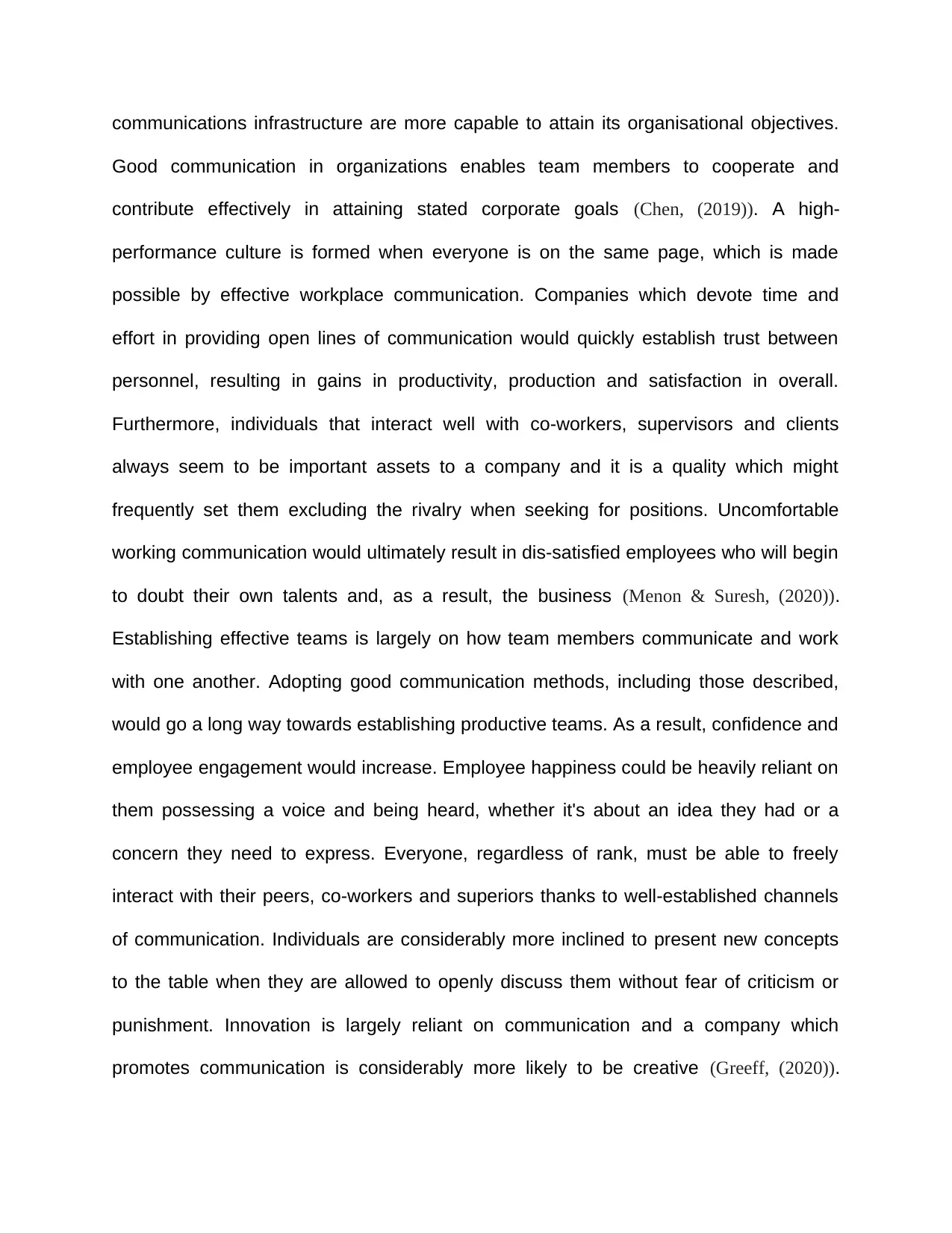
communications infrastructure are more capable to attain its organisational objectives.
Good communication in organizations enables team members to cooperate and
contribute effectively in attaining stated corporate goals (Chen, (2019)). A high-
performance culture is formed when everyone is on the same page, which is made
possible by effective workplace communication. Companies which devote time and
effort in providing open lines of communication would quickly establish trust between
personnel, resulting in gains in productivity, production and satisfaction in overall.
Furthermore, individuals that interact well with co-workers, supervisors and clients
always seem to be important assets to a company and it is a quality which might
frequently set them excluding the rivalry when seeking for positions. Uncomfortable
working communication would ultimately result in dis-satisfied employees who will begin
to doubt their own talents and, as a result, the business (Menon & Suresh, (2020)).
Establishing effective teams is largely on how team members communicate and work
with one another. Adopting good communication methods, including those described,
would go a long way towards establishing productive teams. As a result, confidence and
employee engagement would increase. Employee happiness could be heavily reliant on
them possessing a voice and being heard, whether it's about an idea they had or a
concern they need to express. Everyone, regardless of rank, must be able to freely
interact with their peers, co-workers and superiors thanks to well-established channels
of communication. Individuals are considerably more inclined to present new concepts
to the table when they are allowed to openly discuss them without fear of criticism or
punishment. Innovation is largely reliant on communication and a company which
promotes communication is considerably more likely to be creative (Greeff, (2020)).
Good communication in organizations enables team members to cooperate and
contribute effectively in attaining stated corporate goals (Chen, (2019)). A high-
performance culture is formed when everyone is on the same page, which is made
possible by effective workplace communication. Companies which devote time and
effort in providing open lines of communication would quickly establish trust between
personnel, resulting in gains in productivity, production and satisfaction in overall.
Furthermore, individuals that interact well with co-workers, supervisors and clients
always seem to be important assets to a company and it is a quality which might
frequently set them excluding the rivalry when seeking for positions. Uncomfortable
working communication would ultimately result in dis-satisfied employees who will begin
to doubt their own talents and, as a result, the business (Menon & Suresh, (2020)).
Establishing effective teams is largely on how team members communicate and work
with one another. Adopting good communication methods, including those described,
would go a long way towards establishing productive teams. As a result, confidence and
employee engagement would increase. Employee happiness could be heavily reliant on
them possessing a voice and being heard, whether it's about an idea they had or a
concern they need to express. Everyone, regardless of rank, must be able to freely
interact with their peers, co-workers and superiors thanks to well-established channels
of communication. Individuals are considerably more inclined to present new concepts
to the table when they are allowed to openly discuss them without fear of criticism or
punishment. Innovation is largely reliant on communication and a company which
promotes communication is considerably more likely to be creative (Greeff, (2020)).
Paraphrase This Document
Need a fresh take? Get an instant paraphrase of this document with our AI Paraphraser
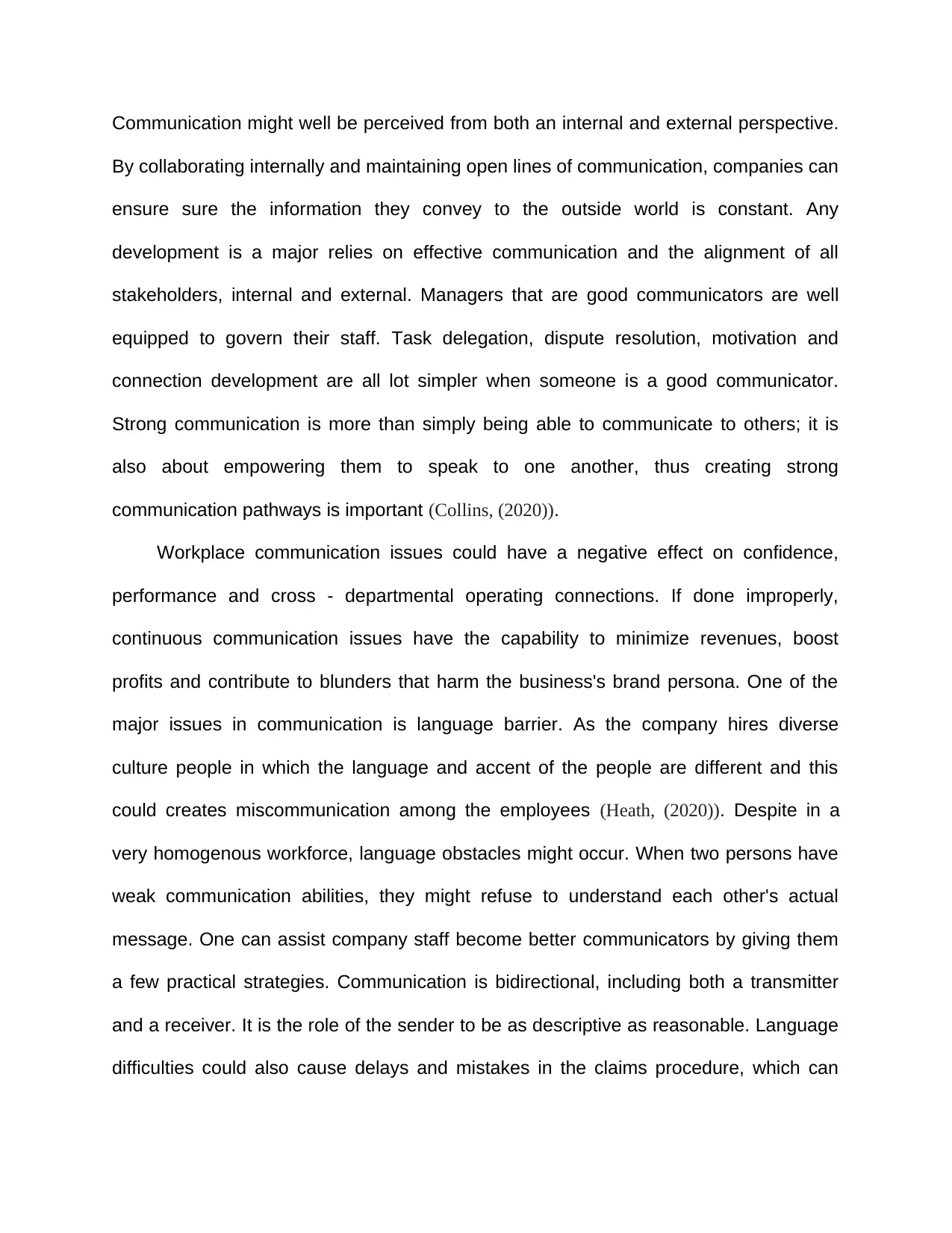
Communication might well be perceived from both an internal and external perspective.
By collaborating internally and maintaining open lines of communication, companies can
ensure sure the information they convey to the outside world is constant. Any
development is a major relies on effective communication and the alignment of all
stakeholders, internal and external. Managers that are good communicators are well
equipped to govern their staff. Task delegation, dispute resolution, motivation and
connection development are all lot simpler when someone is a good communicator.
Strong communication is more than simply being able to communicate to others; it is
also about empowering them to speak to one another, thus creating strong
communication pathways is important (Collins, (2020)).
Workplace communication issues could have a negative effect on confidence,
performance and cross - departmental operating connections. If done improperly,
continuous communication issues have the capability to minimize revenues, boost
profits and contribute to blunders that harm the business's brand persona. One of the
major issues in communication is language barrier. As the company hires diverse
culture people in which the language and accent of the people are different and this
could creates miscommunication among the employees (Heath, (2020)). Despite in a
very homogenous workforce, language obstacles might occur. When two persons have
weak communication abilities, they might refuse to understand each other's actual
message. One can assist company staff become better communicators by giving them
a few practical strategies. Communication is bidirectional, including both a transmitter
and a receiver. It is the role of the sender to be as descriptive as reasonable. Language
difficulties could also cause delays and mistakes in the claims procedure, which can
By collaborating internally and maintaining open lines of communication, companies can
ensure sure the information they convey to the outside world is constant. Any
development is a major relies on effective communication and the alignment of all
stakeholders, internal and external. Managers that are good communicators are well
equipped to govern their staff. Task delegation, dispute resolution, motivation and
connection development are all lot simpler when someone is a good communicator.
Strong communication is more than simply being able to communicate to others; it is
also about empowering them to speak to one another, thus creating strong
communication pathways is important (Collins, (2020)).
Workplace communication issues could have a negative effect on confidence,
performance and cross - departmental operating connections. If done improperly,
continuous communication issues have the capability to minimize revenues, boost
profits and contribute to blunders that harm the business's brand persona. One of the
major issues in communication is language barrier. As the company hires diverse
culture people in which the language and accent of the people are different and this
could creates miscommunication among the employees (Heath, (2020)). Despite in a
very homogenous workforce, language obstacles might occur. When two persons have
weak communication abilities, they might refuse to understand each other's actual
message. One can assist company staff become better communicators by giving them
a few practical strategies. Communication is bidirectional, including both a transmitter
and a receiver. It is the role of the sender to be as descriptive as reasonable. Language
difficulties could also cause delays and mistakes in the claims procedure, which can
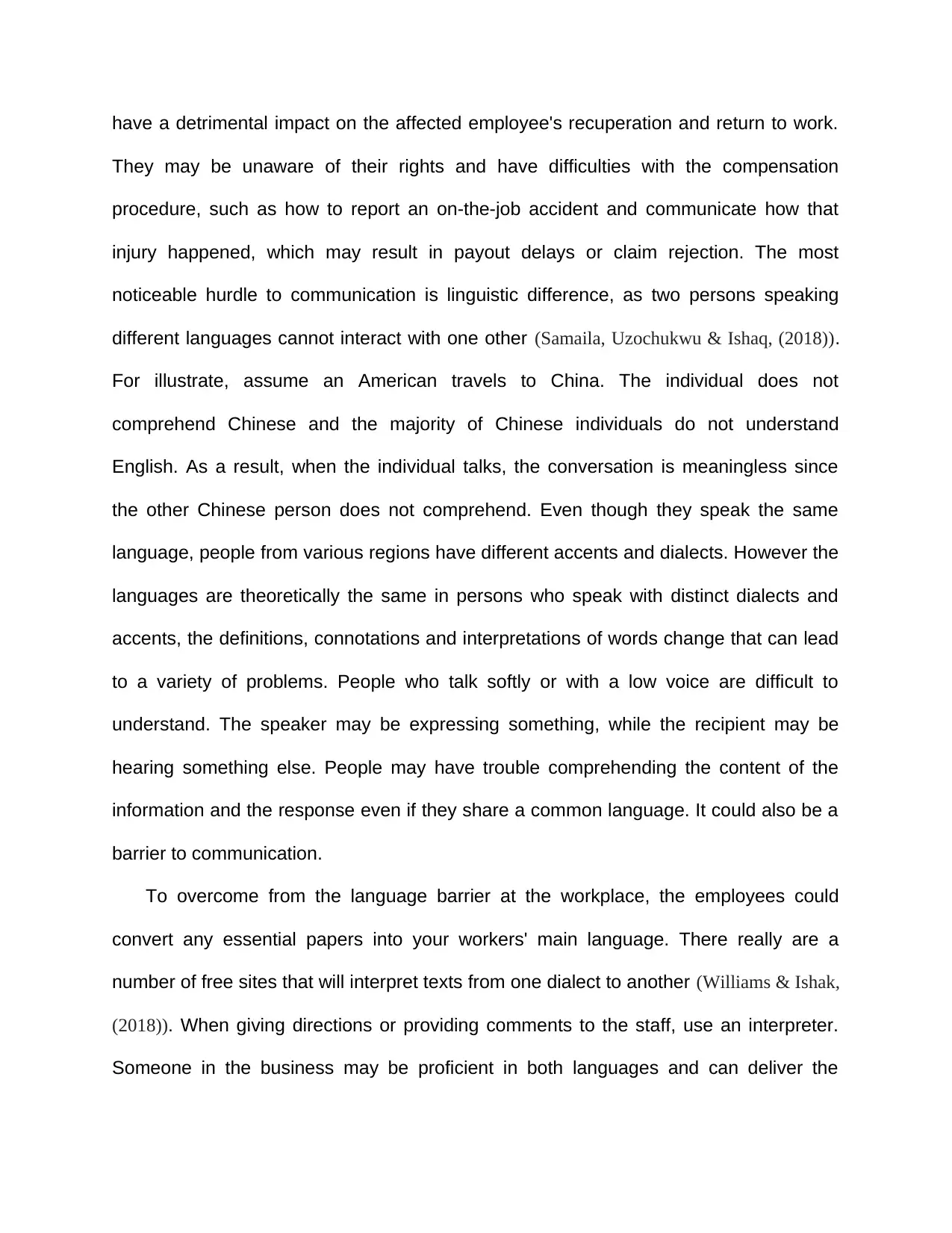
have a detrimental impact on the affected employee's recuperation and return to work.
They may be unaware of their rights and have difficulties with the compensation
procedure, such as how to report an on-the-job accident and communicate how that
injury happened, which may result in payout delays or claim rejection. The most
noticeable hurdle to communication is linguistic difference, as two persons speaking
different languages cannot interact with one other (Samaila, Uzochukwu & Ishaq, (2018)).
For illustrate, assume an American travels to China. The individual does not
comprehend Chinese and the majority of Chinese individuals do not understand
English. As a result, when the individual talks, the conversation is meaningless since
the other Chinese person does not comprehend. Even though they speak the same
language, people from various regions have different accents and dialects. However the
languages are theoretically the same in persons who speak with distinct dialects and
accents, the definitions, connotations and interpretations of words change that can lead
to a variety of problems. People who talk softly or with a low voice are difficult to
understand. The speaker may be expressing something, while the recipient may be
hearing something else. People may have trouble comprehending the content of the
information and the response even if they share a common language. It could also be a
barrier to communication.
To overcome from the language barrier at the workplace, the employees could
convert any essential papers into your workers' main language. There really are a
number of free sites that will interpret texts from one dialect to another (Williams & Ishak,
(2018)). When giving directions or providing comments to the staff, use an interpreter.
Someone in the business may be proficient in both languages and can deliver the
They may be unaware of their rights and have difficulties with the compensation
procedure, such as how to report an on-the-job accident and communicate how that
injury happened, which may result in payout delays or claim rejection. The most
noticeable hurdle to communication is linguistic difference, as two persons speaking
different languages cannot interact with one other (Samaila, Uzochukwu & Ishaq, (2018)).
For illustrate, assume an American travels to China. The individual does not
comprehend Chinese and the majority of Chinese individuals do not understand
English. As a result, when the individual talks, the conversation is meaningless since
the other Chinese person does not comprehend. Even though they speak the same
language, people from various regions have different accents and dialects. However the
languages are theoretically the same in persons who speak with distinct dialects and
accents, the definitions, connotations and interpretations of words change that can lead
to a variety of problems. People who talk softly or with a low voice are difficult to
understand. The speaker may be expressing something, while the recipient may be
hearing something else. People may have trouble comprehending the content of the
information and the response even if they share a common language. It could also be a
barrier to communication.
To overcome from the language barrier at the workplace, the employees could
convert any essential papers into your workers' main language. There really are a
number of free sites that will interpret texts from one dialect to another (Williams & Ishak,
(2018)). When giving directions or providing comments to the staff, use an interpreter.
Someone in the business may be proficient in both languages and can deliver the
⊘ This is a preview!⊘
Do you want full access?
Subscribe today to unlock all pages.

Trusted by 1+ million students worldwide
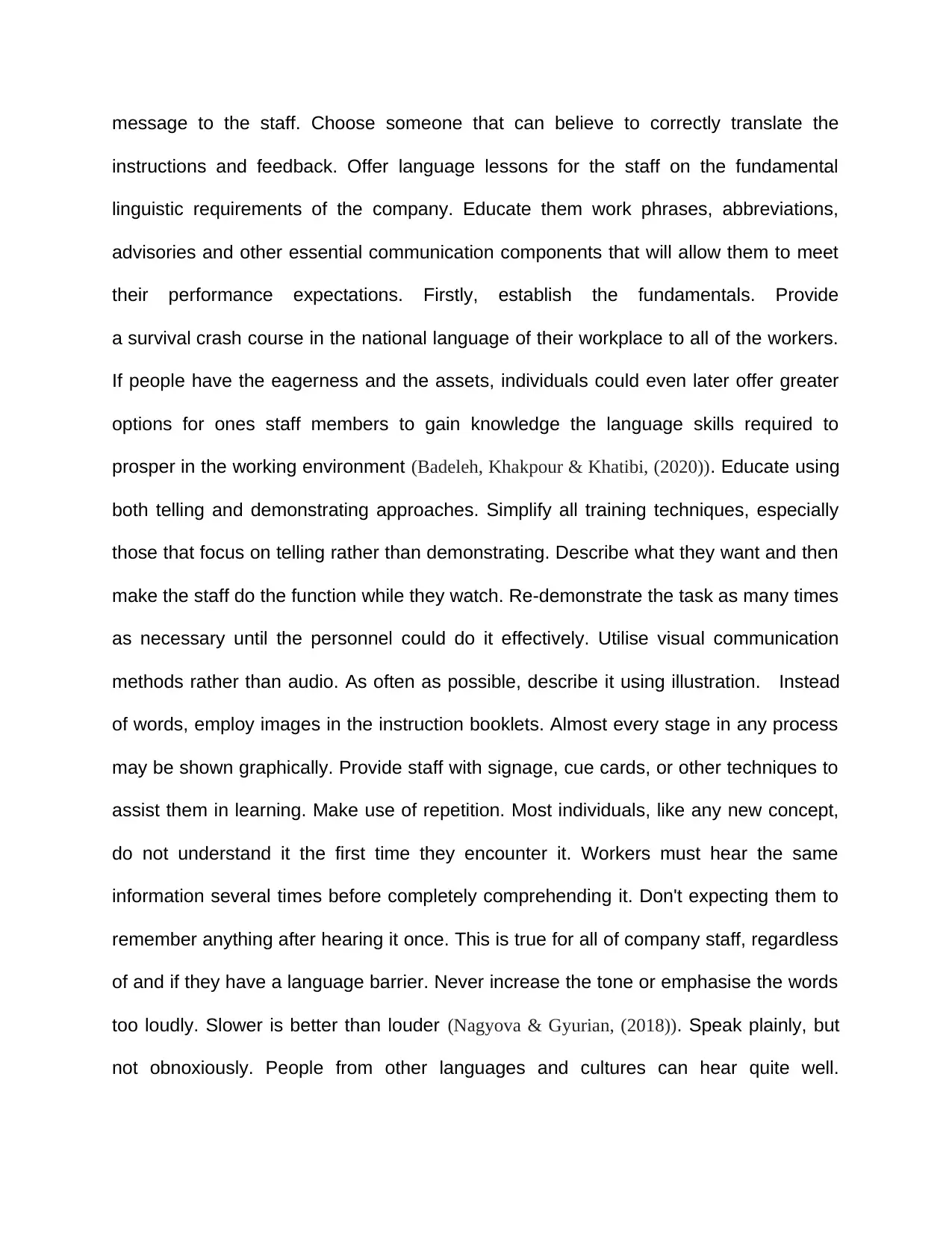
message to the staff. Choose someone that can believe to correctly translate the
instructions and feedback. Offer language lessons for the staff on the fundamental
linguistic requirements of the company. Educate them work phrases, abbreviations,
advisories and other essential communication components that will allow them to meet
their performance expectations. Firstly, establish the fundamentals. Provide
a survival crash course in the national language of their workplace to all of the workers.
If people have the eagerness and the assets, individuals could even later offer greater
options for ones staff members to gain knowledge the language skills required to
prosper in the working environment (Badeleh, Khakpour & Khatibi, (2020)). Educate using
both telling and demonstrating approaches. Simplify all training techniques, especially
those that focus on telling rather than demonstrating. Describe what they want and then
make the staff do the function while they watch. Re-demonstrate the task as many times
as necessary until the personnel could do it effectively. Utilise visual communication
methods rather than audio. As often as possible, describe it using illustration. Instead
of words, employ images in the instruction booklets. Almost every stage in any process
may be shown graphically. Provide staff with signage, cue cards, or other techniques to
assist them in learning. Make use of repetition. Most individuals, like any new concept,
do not understand it the first time they encounter it. Workers must hear the same
information several times before completely comprehending it. Don't expecting them to
remember anything after hearing it once. This is true for all of company staff, regardless
of and if they have a language barrier. Never increase the tone or emphasise the words
too loudly. Slower is better than louder (Nagyova & Gyurian, (2018)). Speak plainly, but
not obnoxiously. People from other languages and cultures can hear quite well.
instructions and feedback. Offer language lessons for the staff on the fundamental
linguistic requirements of the company. Educate them work phrases, abbreviations,
advisories and other essential communication components that will allow them to meet
their performance expectations. Firstly, establish the fundamentals. Provide
a survival crash course in the national language of their workplace to all of the workers.
If people have the eagerness and the assets, individuals could even later offer greater
options for ones staff members to gain knowledge the language skills required to
prosper in the working environment (Badeleh, Khakpour & Khatibi, (2020)). Educate using
both telling and demonstrating approaches. Simplify all training techniques, especially
those that focus on telling rather than demonstrating. Describe what they want and then
make the staff do the function while they watch. Re-demonstrate the task as many times
as necessary until the personnel could do it effectively. Utilise visual communication
methods rather than audio. As often as possible, describe it using illustration. Instead
of words, employ images in the instruction booklets. Almost every stage in any process
may be shown graphically. Provide staff with signage, cue cards, or other techniques to
assist them in learning. Make use of repetition. Most individuals, like any new concept,
do not understand it the first time they encounter it. Workers must hear the same
information several times before completely comprehending it. Don't expecting them to
remember anything after hearing it once. This is true for all of company staff, regardless
of and if they have a language barrier. Never increase the tone or emphasise the words
too loudly. Slower is better than louder (Nagyova & Gyurian, (2018)). Speak plainly, but
not obnoxiously. People from other languages and cultures can hear quite well.
Paraphrase This Document
Need a fresh take? Get an instant paraphrase of this document with our AI Paraphraser
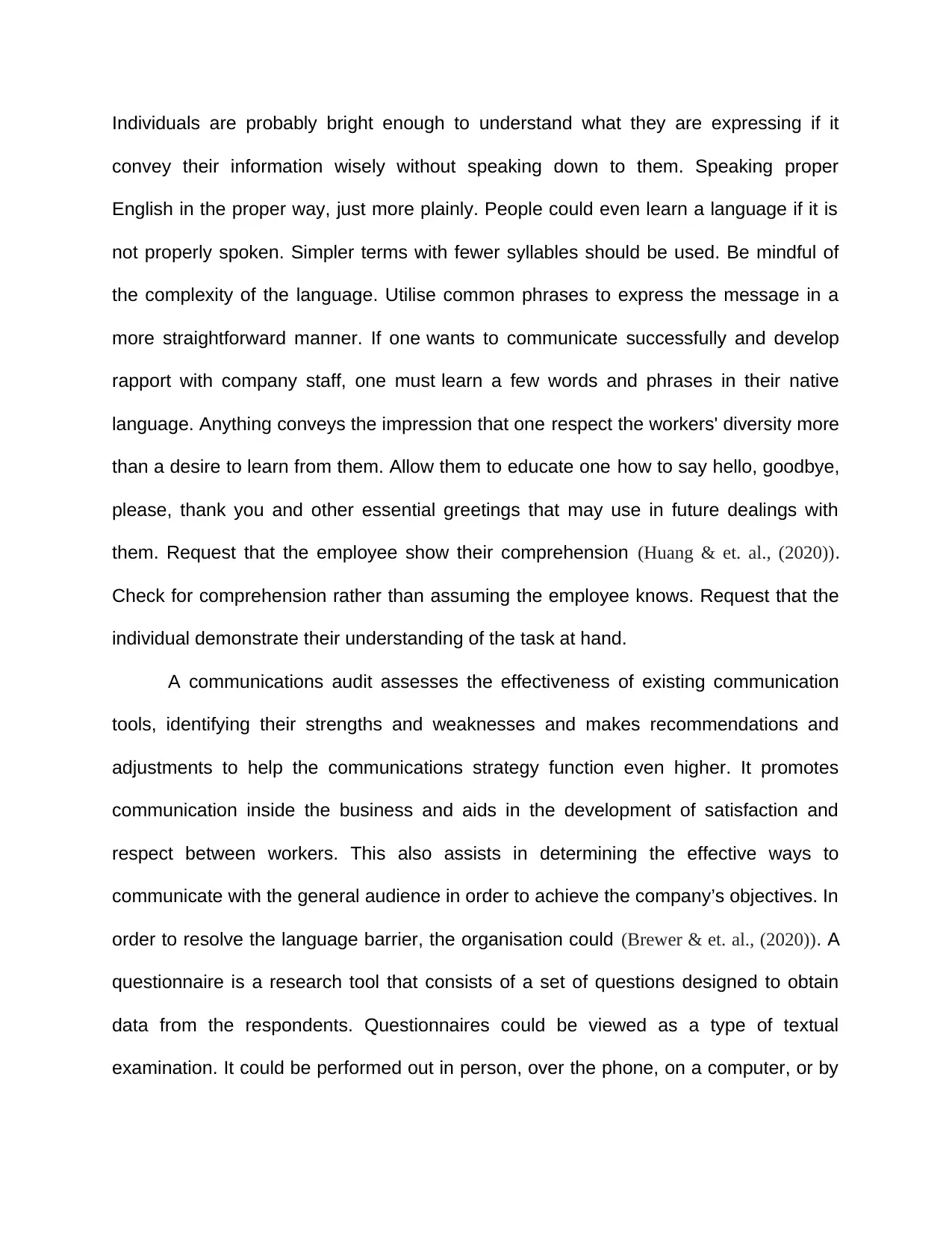
Individuals are probably bright enough to understand what they are expressing if it
convey their information wisely without speaking down to them. Speaking proper
English in the proper way, just more plainly. People could even learn a language if it is
not properly spoken. Simpler terms with fewer syllables should be used. Be mindful of
the complexity of the language. Utilise common phrases to express the message in a
more straightforward manner. If one wants to communicate successfully and develop
rapport with company staff, one must learn a few words and phrases in their native
language. Anything conveys the impression that one respect the workers' diversity more
than a desire to learn from them. Allow them to educate one how to say hello, goodbye,
please, thank you and other essential greetings that may use in future dealings with
them. Request that the employee show their comprehension (Huang & et. al., (2020)).
Check for comprehension rather than assuming the employee knows. Request that the
individual demonstrate their understanding of the task at hand.
A communications audit assesses the effectiveness of existing communication
tools, identifying their strengths and weaknesses and makes recommendations and
adjustments to help the communications strategy function even higher. It promotes
communication inside the business and aids in the development of satisfaction and
respect between workers. This also assists in determining the effective ways to
communicate with the general audience in order to achieve the company’s objectives. In
order to resolve the language barrier, the organisation could (Brewer & et. al., (2020)). A
questionnaire is a research tool that consists of a set of questions designed to obtain
data from the respondents. Questionnaires could be viewed as a type of textual
examination. It could be performed out in person, over the phone, on a computer, or by
convey their information wisely without speaking down to them. Speaking proper
English in the proper way, just more plainly. People could even learn a language if it is
not properly spoken. Simpler terms with fewer syllables should be used. Be mindful of
the complexity of the language. Utilise common phrases to express the message in a
more straightforward manner. If one wants to communicate successfully and develop
rapport with company staff, one must learn a few words and phrases in their native
language. Anything conveys the impression that one respect the workers' diversity more
than a desire to learn from them. Allow them to educate one how to say hello, goodbye,
please, thank you and other essential greetings that may use in future dealings with
them. Request that the employee show their comprehension (Huang & et. al., (2020)).
Check for comprehension rather than assuming the employee knows. Request that the
individual demonstrate their understanding of the task at hand.
A communications audit assesses the effectiveness of existing communication
tools, identifying their strengths and weaknesses and makes recommendations and
adjustments to help the communications strategy function even higher. It promotes
communication inside the business and aids in the development of satisfaction and
respect between workers. This also assists in determining the effective ways to
communicate with the general audience in order to achieve the company’s objectives. In
order to resolve the language barrier, the organisation could (Brewer & et. al., (2020)). A
questionnaire is a research tool that consists of a set of questions designed to obtain
data from the respondents. Questionnaires could be viewed as a type of textual
examination. It could be performed out in person, over the phone, on a computer, or by
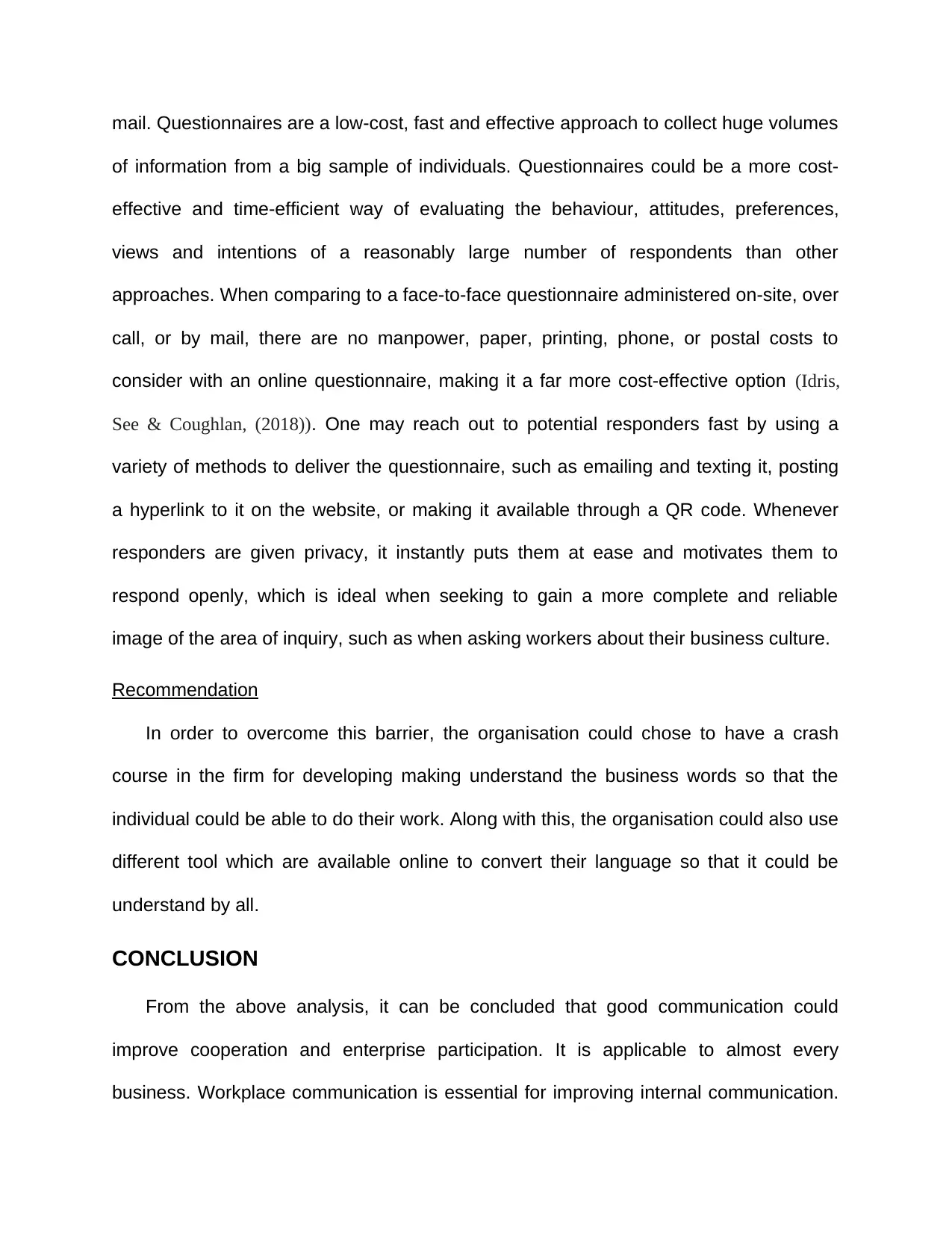
mail. Questionnaires are a low-cost, fast and effective approach to collect huge volumes
of information from a big sample of individuals. Questionnaires could be a more cost-
effective and time-efficient way of evaluating the behaviour, attitudes, preferences,
views and intentions of a reasonably large number of respondents than other
approaches. When comparing to a face-to-face questionnaire administered on-site, over
call, or by mail, there are no manpower, paper, printing, phone, or postal costs to
consider with an online questionnaire, making it a far more cost-effective option (Idris,
See & Coughlan, (2018)). One may reach out to potential responders fast by using a
variety of methods to deliver the questionnaire, such as emailing and texting it, posting
a hyperlink to it on the website, or making it available through a QR code. Whenever
responders are given privacy, it instantly puts them at ease and motivates them to
respond openly, which is ideal when seeking to gain a more complete and reliable
image of the area of inquiry, such as when asking workers about their business culture.
Recommendation
In order to overcome this barrier, the organisation could chose to have a crash
course in the firm for developing making understand the business words so that the
individual could be able to do their work. Along with this, the organisation could also use
different tool which are available online to convert their language so that it could be
understand by all.
CONCLUSION
From the above analysis, it can be concluded that good communication could
improve cooperation and enterprise participation. It is applicable to almost every
business. Workplace communication is essential for improving internal communication.
of information from a big sample of individuals. Questionnaires could be a more cost-
effective and time-efficient way of evaluating the behaviour, attitudes, preferences,
views and intentions of a reasonably large number of respondents than other
approaches. When comparing to a face-to-face questionnaire administered on-site, over
call, or by mail, there are no manpower, paper, printing, phone, or postal costs to
consider with an online questionnaire, making it a far more cost-effective option (Idris,
See & Coughlan, (2018)). One may reach out to potential responders fast by using a
variety of methods to deliver the questionnaire, such as emailing and texting it, posting
a hyperlink to it on the website, or making it available through a QR code. Whenever
responders are given privacy, it instantly puts them at ease and motivates them to
respond openly, which is ideal when seeking to gain a more complete and reliable
image of the area of inquiry, such as when asking workers about their business culture.
Recommendation
In order to overcome this barrier, the organisation could chose to have a crash
course in the firm for developing making understand the business words so that the
individual could be able to do their work. Along with this, the organisation could also use
different tool which are available online to convert their language so that it could be
understand by all.
CONCLUSION
From the above analysis, it can be concluded that good communication could
improve cooperation and enterprise participation. It is applicable to almost every
business. Workplace communication is essential for improving internal communication.
⊘ This is a preview!⊘
Do you want full access?
Subscribe today to unlock all pages.

Trusted by 1+ million students worldwide
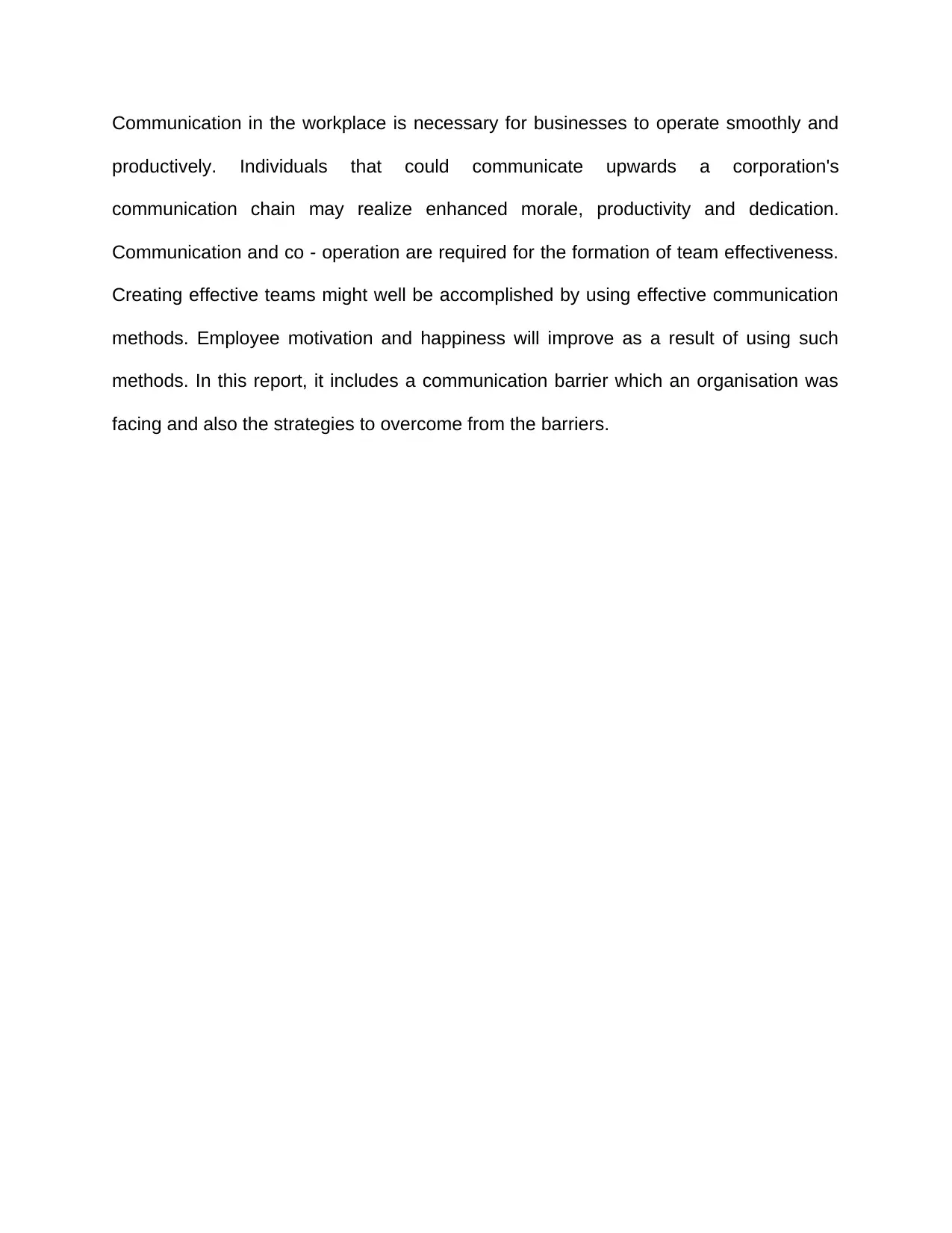
Communication in the workplace is necessary for businesses to operate smoothly and
productively. Individuals that could communicate upwards a corporation's
communication chain may realize enhanced morale, productivity and dedication.
Communication and co - operation are required for the formation of team effectiveness.
Creating effective teams might well be accomplished by using effective communication
methods. Employee motivation and happiness will improve as a result of using such
methods. In this report, it includes a communication barrier which an organisation was
facing and also the strategies to overcome from the barriers.
productively. Individuals that could communicate upwards a corporation's
communication chain may realize enhanced morale, productivity and dedication.
Communication and co - operation are required for the formation of team effectiveness.
Creating effective teams might well be accomplished by using effective communication
methods. Employee motivation and happiness will improve as a result of using such
methods. In this report, it includes a communication barrier which an organisation was
facing and also the strategies to overcome from the barriers.
Paraphrase This Document
Need a fresh take? Get an instant paraphrase of this document with our AI Paraphraser
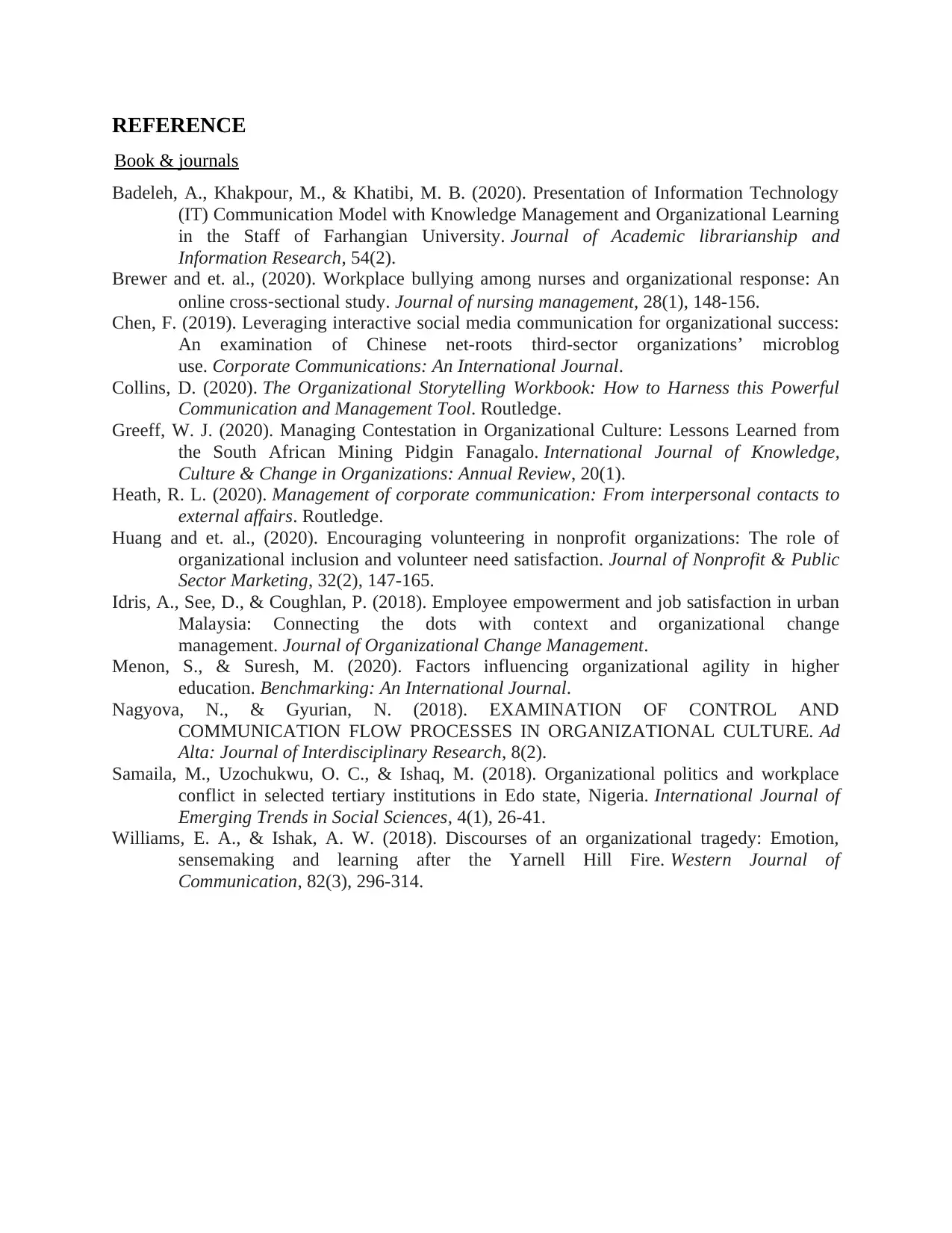
REFERENCE
Book & journals
Badeleh, A., Khakpour, M., & Khatibi, M. B. (2020). Presentation of Information Technology
(IT) Communication Model with Knowledge Management and Organizational Learning
in the Staff of Farhangian University. Journal of Academic librarianship and
Information Research, 54(2).
Brewer and et. al., (2020). Workplace bullying among nurses and organizational response: An
online cross‐sectional study. Journal of nursing management, 28(1), 148-156.
Chen, F. (2019). Leveraging interactive social media communication for organizational success:
An examination of Chinese net-roots third-sector organizations’ microblog
use. Corporate Communications: An International Journal.
Collins, D. (2020). The Organizational Storytelling Workbook: How to Harness this Powerful
Communication and Management Tool. Routledge.
Greeff, W. J. (2020). Managing Contestation in Organizational Culture: Lessons Learned from
the South African Mining Pidgin Fanagalo. International Journal of Knowledge,
Culture & Change in Organizations: Annual Review, 20(1).
Heath, R. L. (2020). Management of corporate communication: From interpersonal contacts to
external affairs. Routledge.
Huang and et. al., (2020). Encouraging volunteering in nonprofit organizations: The role of
organizational inclusion and volunteer need satisfaction. Journal of Nonprofit & Public
Sector Marketing, 32(2), 147-165.
Idris, A., See, D., & Coughlan, P. (2018). Employee empowerment and job satisfaction in urban
Malaysia: Connecting the dots with context and organizational change
management. Journal of Organizational Change Management.
Menon, S., & Suresh, M. (2020). Factors influencing organizational agility in higher
education. Benchmarking: An International Journal.
Nagyova, N., & Gyurian, N. (2018). EXAMINATION OF CONTROL AND
COMMUNICATION FLOW PROCESSES IN ORGANIZATIONAL CULTURE. Ad
Alta: Journal of Interdisciplinary Research, 8(2).
Samaila, M., Uzochukwu, O. C., & Ishaq, M. (2018). Organizational politics and workplace
conflict in selected tertiary institutions in Edo state, Nigeria. International Journal of
Emerging Trends in Social Sciences, 4(1), 26-41.
Williams, E. A., & Ishak, A. W. (2018). Discourses of an organizational tragedy: Emotion,
sensemaking and learning after the Yarnell Hill Fire. Western Journal of
Communication, 82(3), 296-314.
Book & journals
Badeleh, A., Khakpour, M., & Khatibi, M. B. (2020). Presentation of Information Technology
(IT) Communication Model with Knowledge Management and Organizational Learning
in the Staff of Farhangian University. Journal of Academic librarianship and
Information Research, 54(2).
Brewer and et. al., (2020). Workplace bullying among nurses and organizational response: An
online cross‐sectional study. Journal of nursing management, 28(1), 148-156.
Chen, F. (2019). Leveraging interactive social media communication for organizational success:
An examination of Chinese net-roots third-sector organizations’ microblog
use. Corporate Communications: An International Journal.
Collins, D. (2020). The Organizational Storytelling Workbook: How to Harness this Powerful
Communication and Management Tool. Routledge.
Greeff, W. J. (2020). Managing Contestation in Organizational Culture: Lessons Learned from
the South African Mining Pidgin Fanagalo. International Journal of Knowledge,
Culture & Change in Organizations: Annual Review, 20(1).
Heath, R. L. (2020). Management of corporate communication: From interpersonal contacts to
external affairs. Routledge.
Huang and et. al., (2020). Encouraging volunteering in nonprofit organizations: The role of
organizational inclusion and volunteer need satisfaction. Journal of Nonprofit & Public
Sector Marketing, 32(2), 147-165.
Idris, A., See, D., & Coughlan, P. (2018). Employee empowerment and job satisfaction in urban
Malaysia: Connecting the dots with context and organizational change
management. Journal of Organizational Change Management.
Menon, S., & Suresh, M. (2020). Factors influencing organizational agility in higher
education. Benchmarking: An International Journal.
Nagyova, N., & Gyurian, N. (2018). EXAMINATION OF CONTROL AND
COMMUNICATION FLOW PROCESSES IN ORGANIZATIONAL CULTURE. Ad
Alta: Journal of Interdisciplinary Research, 8(2).
Samaila, M., Uzochukwu, O. C., & Ishaq, M. (2018). Organizational politics and workplace
conflict in selected tertiary institutions in Edo state, Nigeria. International Journal of
Emerging Trends in Social Sciences, 4(1), 26-41.
Williams, E. A., & Ishak, A. W. (2018). Discourses of an organizational tragedy: Emotion,
sensemaking and learning after the Yarnell Hill Fire. Western Journal of
Communication, 82(3), 296-314.
1 out of 11
Related Documents
Your All-in-One AI-Powered Toolkit for Academic Success.
+13062052269
info@desklib.com
Available 24*7 on WhatsApp / Email
![[object Object]](/_next/static/media/star-bottom.7253800d.svg)
Unlock your academic potential
Copyright © 2020–2025 A2Z Services. All Rights Reserved. Developed and managed by ZUCOL.



